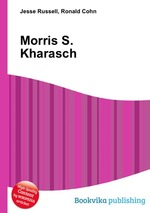Morris S. Kharasch
Jesse Russell Ronald Cohn
бумажная книга
High Quality Content by WIKIPEDIA articles! Morris Selig Kharasch (August 24, 1895 – October 9, 1957) was a pioneering organic chemist best known for his work with free radical additions and polymerizations. He defined the peroxide effect, explaining how an anti-Markovnikov orientation could be achieved via free radical addition. Kharasch was born in Russian Empire in 1895 and immigrated to the United States at the age of 13. In 1919, he completed his Ph.D. in chemistry at the University of Chicago and spent most of his professional career there. Most of his research in the 1920’s focused on organo-mercuric derivatives. He synthesized an important anti-microbial alkyl mercuric sulfur compound, thimerosal, commercially known as Merthiolate, which he patented in 1928 and assigned to the pharmaceutical company Eli Lilly and Company. Merthiolate was introduced as a vaccine preservative in 1931, and by the late 1980’s thimerosal was used in all whole-cell DPT vaccines. Nobel laureate Herbert C. Brown was one of his students during the 1930s. When World War II began, the US government recognized the need for a synthetic rubber and employed the best chemists around the nation to aid in this effort. In 1942 Kharasch joined the American Synthetic Rubber Research Program and applied his knowledge of radical reactions to aid in the polymerization of synthetic styrene. In his later years, Kharasch devoted his attention to studying the Grignard reaction and in 1954 co-authored a book with O. Reinmuth entitled Grignard Reactions of Nonmetallic Substances.


